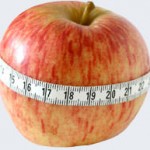Weight Control
 Weight control means weight maintenance that is suitable to your individual body needs—not necessarily eating to lose or gain weight. Your goal in weight control should be disease prevention. One of the major factors causing disease is excessive weight for your body structure.
Weight control means weight maintenance that is suitable to your individual body needs—not necessarily eating to lose or gain weight. Your goal in weight control should be disease prevention. One of the major factors causing disease is excessive weight for your body structure.
Weight gain, loss, or maintenance should address individual needs with notation to your Body Mass Index (BMI). The BMI chart gives a guideline on what your individual average weight goal should be. This guideline just gives you an idea on your ideal weight range. A BMI of 19 to 25 is considered a healthy weight range. An individual with a BMI below 19 is considered to be underweight. An individual with a BMI of 26 to 29 is considered overweight. A BMI of 30 or greater is considered obese.
To identify the ideal weight range for your height, find your BMI on the table below. To use the table, find your height in inches in the left-hand column labeled Height (example: 5 feet = 60 inches). Move across to the right and find your current weight range(in pounds). Where you find your current weight range, move straight up that column to the line marked BMI. The number you come to on the line marked BMI is your BMI. Pounds have been rounded off.
| BMI | 19 | 20 | 21 | 22 | 23 | 24 | 25 | 26 | 27 | 28 | 29 | 30 | 31 | 32 | 33 | 34 | 35 |
| Height (inches) |
Body Weight (pounds) | ||||||||||||||||
| 58 | 91 | 96 | 100 | 105 | 110 | 115 | 119 | 124 | 129 | 134 | 138 | 143 | 148 | 153 | 158 | 162 | 167 |
| 59 | 94 | 99 | 104 | 109 | 114 | 119 | 124 | 128 | 133 | 138 | 143 | 148 | 153 | 158 | 163 | 168 | 173 |
| 60 | 97 | 102 | 107 | 112 | 118 | 123 | 128 | 133 | 138 | 143 | 148 | 153 | 158 | 163 | 168 | 174 | 179 |
| 61 | 100 | 106 | 111 | 116 | 122 | 127 | 132 | 137 | 143 | 148 | 153 | 158 | 164 | 169 | 174 | 180 | 185 |
| 62 | 104 | 109 | 115 | 120 | 126 | 131 | 136 | 142 | 147 | 153 | 158 | 164 | 169 | 175 | 180 | 186 | 191 |
| 63 | 107 | 113 | 118 | 124 | 130 | 135 | 141 | 146 | 152 | 158 | 163 | 169 | 175 | 180 | 186 | 191 | 197 |
| 64 | 110 | 116 | 122 | 128 | 134 | 140 | 145 | 151 | 157 | 163 | 169 | 174 | 180 | 186 | 192 | 197 | 204 |
| 65 | 114 | 120 | 126 | 132 | 138 | 144 | 150 | 156 | 162 | 168 | 174 | 180 | 186 | 192 | 198 | 204 | 210 |
| 66 | 118 | 124 | 130 | 136 | 142 | 148 | 155 | 161 | 167 | 173 | 179 | 186 | 192 | 198 | 204 | 210 | 216 |
| 67 | 121 | 127 | 134 | 140 | 146 | 153 | 159 | 166 | 172 | 178 | 185 | 191 | 198 | 204 | 211 | 217 | 223 |
| 68 | 125 | 131 | 138 | 144 | 151 | 158 | 164 | 171 | 177 | 184 | 190 | 197 | 203 | 210 | 216 | 223 | 230 |
| 69 | 128 | 135 | 142 | 149 | 155 | 162 | 169 | 176 | 182 | 189 | 196 | 203 | 209 | 216 | 223 | 230 | 236 |
| 70 | 132 | 139 | 146 | 153 | 160 | 167 | 174 | 181 | 188 | 195 | 202 | 209 | 216 | 222 | 229 | 236 | 243 |
| 71 | 136 | 143 | 150 | 157 | 165 | 172 | 179 | 186 | 193 | 200 | 208 | 215 | 222 | 229 | 236 | 243 | 250 |
| 72 | 140 | 147 | 154 | 162 | 169 | 177 | 184 | 191 | 199 | 206 | 213 | 221 | 228 | 235 | 242 | 250 | 258 |
| 73 | 144 | 151 | 159 | 166 | 174 | 182 | 189 | 197 | 204 | 212 | 219 | 227 | 235 | 242 | 250 | 257 | 265 |
| 74 | 148 | 155 | 163 | 171 | 179 | 186 | 194 | 202 | 210 | 218 | 225 | 233 | 241 | 249 | 256 | 264 | 272 |
| 75 | 152 | 160 | 168 | 176 | 184 | 192 | 200 | 208 | 216 | 224 | 232 | 240 | 248 | 256 | 264 | 272 | 279 |
| 76 | 156 | 164 | 172 | 180 | 189 | 197 | 205 | 213 | 221 | 230 | 238 | 246 | 254 | 263 | 271 | 279 | 287 |
In those who have a muscular build or those older individuals who have lost muscle mass, the BMI table may not give an accurate assessment of healthy weight range. However, the BMI table gives a good assessment of healthy weight range.
Waist circumference is also a consideration. Waist circumference above 35 for women and 40 for men has been considered a risk for heart disease. Diet noting food portions, exercise, and lifestyle habits like avoiding junk foods, cigarette smoking, and too much alcohol, are also significant to maintaining a healthy weight range. For more information on healthy weight control, visit the website: www.nhlbi.nih.gov/health/public/heart/obesity/wecan/index.htm. A video message by Michelle Obama is featured on this site with the weight control campaign “We Can”.



